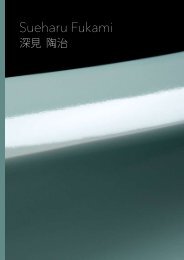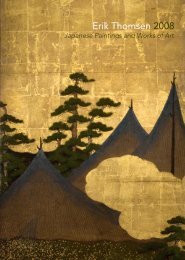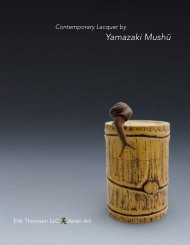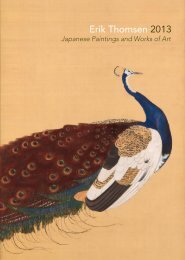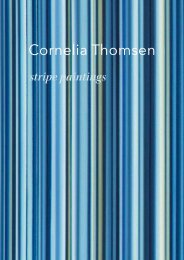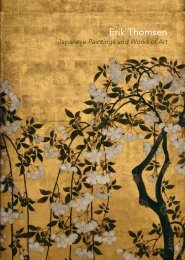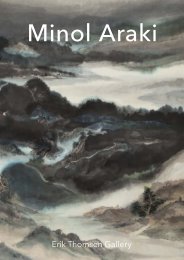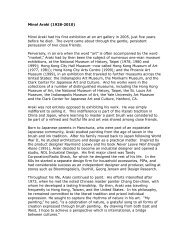View publication (pdf file 6.5 mb) - Erik Thomsen
View publication (pdf file 6.5 mb) - Erik Thomsen
View publication (pdf file 6.5 mb) - Erik Thomsen
- No tags were found...
Create successful ePaper yourself
Turn your PDF publications into a flip-book with our unique Google optimized e-Paper software.
19Tsuji Kakō 都 路 華 杳 (1870 –1931)Daruma PortraitTaishō Period (1912 – 26), circa 1915H 46 ¼" × W 16 ¼" (incl. mounting 84 ¾" × 23")(117.2 cm × 41 cm, 215 cm × 58.2 cm)Hanging scroll, ink and colors on paperSignature, painting: Kakō 華 香Seal, painting: Kakō 華 香Box inscription, top:»Painting of Bodhidharma« 菩 提 達 磨 図Box inscription, signature and seal inside:»Title by Kakō« 華 香 題 and Shishun 子 春This striking portrait of the First Patriarch of Buddhism,Bodhidharma (Japanese: Daruma) waspainted by the noted Nihonga artist Kakō in theTaishō period. The body and robe of the patriarchare painted with strokes of abstracted repetitions,varying only in density. The heavy layering of coloron Daruma’s chest has resulted in an interestingmottling of the surface, giving a realistic touch.Kakō created a series of Daruma portraits in the1910’s 1 ; as in the other extant examples, there isalso here an emphasis on the chest and the generalhairiness of the Indian patriarch. 2One may well ask why a Nihonga artist would painta series of Daruma images, a topic one wouldrather expect from Zen monks. One reason is Kakō’sstrong belief in Zen Buddhism, which is reflectedin the thirty years of religious training he underwentwith the monk Mokurai (1854 –1930), a Zen Buddhistabbot of the Kenninji Temple in Kyoto. 3 Further,the historical and textual roots of Buddhism werean important theme for the intellectuals of the Taishōperiod. This was the time of the compilation and<strong>publication</strong> of the great Taishō shinshū Daizōkyō, amonumental work of Buddhist scholarship which isstill in use across the world. Therefore an intellectualinterest in Buddhism and in the founder, Daruma,may also have been a reason for the many portraits.Kakō was known for his unusual cutting-edge imagesand succeeds, more than almost any other Japaneseartist of his time, in co<strong>mb</strong>ining Japanese paintingtradition with modernist ideas; here, an old traditionof drawing portraits of Daruma is updated by theartist. 4 For an example of his modernist painting ina screen format, see our 2009 <strong>publication</strong>, item 3.In the past decade, awareness of the artist has growndramatically in the West and Kakō is now well representedin the museums and collections of theWestern world.74



